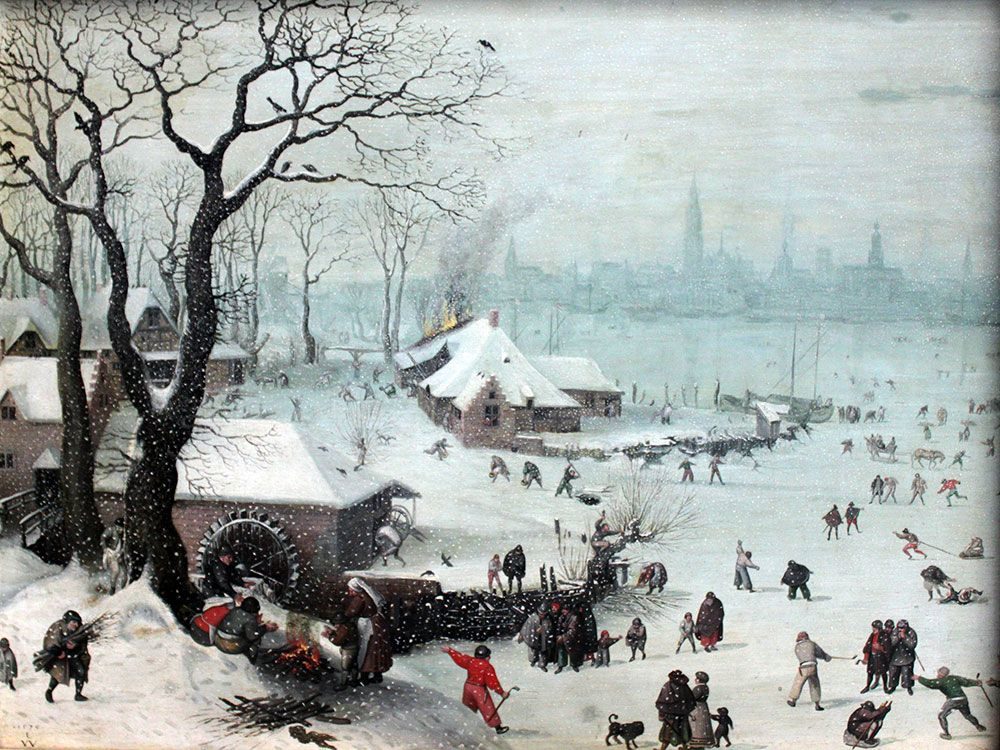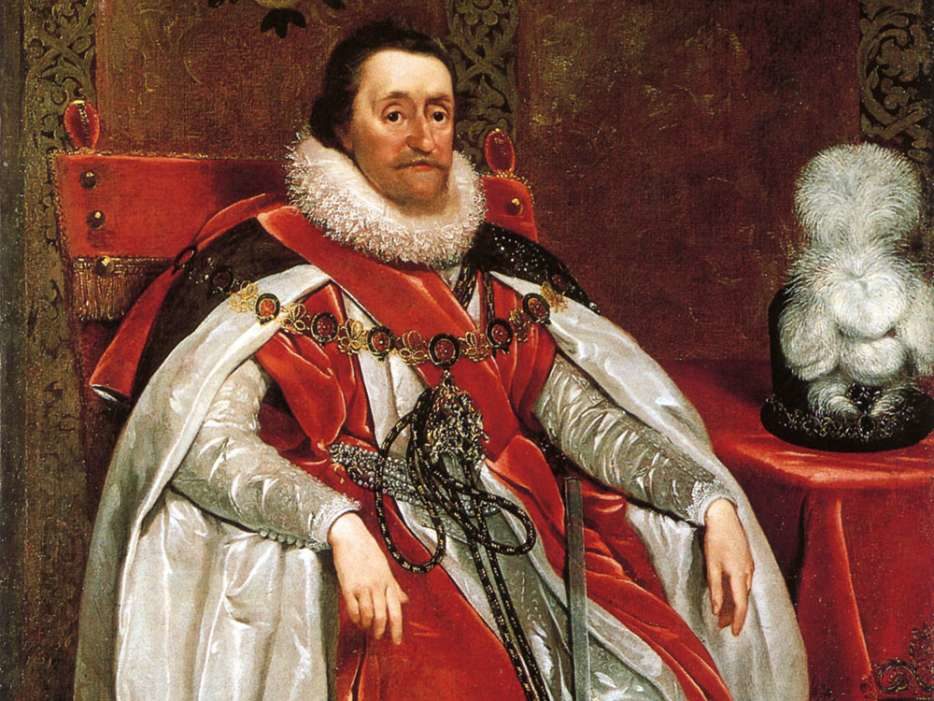
1575 Winter Landscape with Snowfall near Antwerp by Lucas van Valckenborch.
During late 1606 and early 1607, while the first Englishmen sailed to Jamestown, the weather in Europe turned eerily warm and dry. In parts of Germany, the flowers bloomed in February. Coming after decades of cold, wet seasons, it seemed to some that this year there was "no winter" at all.
That suddenly changed in late 1607, when the continent plunged back into some of the worst cold in generations. The winter of 1607-1608 has gone down in history as one of Europe's "great winters," bringing Arctic cold, snow, and ice. In the Netherlands, the freeze began in late December and continued with few interruptions into late March. Horses and sleighs travelled over the Zuiderzee from Haarlingen to Enkhuizen, and the extraordinary sight would inspire some of the most famous winter landscape paintings of the era. Even Spanish diplomats travelled by sleigh over the ice to broker their truce with Dutch rebels in early 1608.
By late winter the rivers were solid and the ground lay under sheets of ice. Birds froze to death; livestock and wild animals starved; fruit trees perished of frost. "In short," Dirk Velius observed from Hoorn, "it was a winter whose like was unheard of in human memory."
His sentiment was echoed all across Europe.
In Ireland, wrote one chronicler, "in the winter of this year was a great frost, which began a little before Christmas, and continued till about Midlent. This frost increased with such fervency of cold that all things which grew above the ground died and starved with cold; many beasts, both wild and tame, died and starved with hunger, and so did great numbers of wild fowls. The rivers for the most part throughout all Ireland were so covered over that the people might go to and fro upon the ice as upon dry land." In Germany, heavy rain and flooding in early winter soon gave way to ice: the Rhine froze all the way up to Cologne, and the Main iced up all the way past Frankfurt. "Not only the vineyards but even the trees in warm valleys froze," noted one contemporary. From Prague, the Venetian ambassador reported snow, ice, and "the greatest, most extraordinary cold." In France, the Loire River froze, and ice floes choked the Rhone. The Seine iced over for nearly two months, so carriages could pass across. Communion wine froze in the churches of Paris and had to be thawed out for mass. Hundreds perished from cold and hunger in the streets of French towns and cities. "The cold was so extreme and the freeze so great and bitter, that nothing seemed like it in the memory of man," wrote the diarist Pierre de l'Estoile.Even the Mediterranean did not escape.
Spain faced bitter cold, frozen rivers, and snowfall as late as May 1608. Northern Italy suffered one of its coldest winters of the Little Ice Age. In Florence, continual rains during December turned to snow and ice throughout January and February; in Milan the ice and snow were supposedly so bad that people could barely go outdoors. In Rome, heavy rains brought frequent flooding of the Tiber.
Lakes and rivers froze in Greece.
In Anatolia, still ravaged by the Celali rebellion, extreme cold and drought induced widespread famine and reportedly cannibalism.The most famous image of that winter remains the frost fair on the frozen Thames in London. In December 1607, ice began to pile up at the old London Bridge. The floes began to freeze together about a week before Christmas, and within three weeks the river turned solid from bank to bank. A few brave souls ventured out on the ice, and soon shops, food stalls, and impromptu parties appeared in the middle of the frozen river. "Many fantastical experiments are dayly put in practise, as certain youths burnt a gallon of wine upon the ice and made all passengers partakers," wrote one contemporary, "but the best is of an honest woman (they say) that had a great longing to have her husband get her with child upon the Thames."
Even in England the winter was not all fun and games.
The year 1607 had already begun badly. In January, a tremendous flood of the River Severn had drowned thousands of people and cattle, an event that excited wonder and dread across the country and beyond. In April, long-standing grievances against rising food prices and the enclosure of common lands erupted in rural riots known as the Midland Revolt. Soldiers promptly crushed the ragtag army of "levellers" and "diggers" that June, but resentments lingered. Anger and despair over continuing high food prices are thought to have inspired Shakespeare's descriptions of rebellious plebes in the opening act of Coriolanus.
The crisis revealed King James I at his most petulant and insensitive. A series of royal proclamations castigated the rioters and denied any connection between the hunger and rebellion. He prohibited farmers from feeding peas to pigs, brewers from using more malt for beer, and even gentlemen from using starch in their lace collars, claiming these measures would spare enough food for the poor. Other proclamations targeted those hoarding and speculating on grain and the new wave of migrants coming to towns and cities in search of employment or relief. But these steps, and even grain imports from the Baltic, failed to hold back rising prices and hunger. The exceptional cold of early 1608 ruined the wheat crop. An Englishman recalled that as far south as Devon, "an extreme dearth of corn happened this year, by reason of extreme frosts (as the like were never seen), the winter going before, which caused much corn to fall away."

Details from a portrait of King James I by Dutch artist Daniel Mytens.
Thomas Dekker penned a satirical almanac that mocked the miseries of the year:
When Charitie blowes her nailes, and is ready to starve, yet not so much as a Watchman will lend her a flap of his freeze Gowne to keepe her warme: when tradesmen shut up shops, by reason their frozen hearted creditors goe about to nip them with beggerie: when the price of Sea-cole riseth, and the price of mens laboures falleth when everie Chimnye castes out smoak, but scarce any dore opens to cast so much as a marlbone to a Dog to gnaw: when beasts die for want of fodder in the field, and men are ready to famish for want of foods in the citie...Bubonic plague, which had flared up from time to time after the great outbreak of 1603, now made new inroads among the poor, hungry, and vagrants. "You have heard before of certaine plagues, and of a Famine that hangs over our heads in the cloudes," Dekker added wryly. "Mis-fortunes are not borne alone, but like married fooles they come in couples."
Dekker's epigram was just as fitting for England's twin colonies in North America. It is often forgotten that Jamestown was only one half of the original Virginia Company venture. Its charter of April 1606 called for a pair of colonies: one to the south, with claims from present-day day North Carolina to New Jersey, and one to the north, with claims ranging from Delaware to Maine. The former — that is, the Jamestown colony — drew London investors hoping for Mediterranean commodities and lured by rumours of gold-bearing mountains and the Verrazzano Sea. The latter attracted West Country investors looking for a land and climate more like England's, offering goods such as timber and fish, besides the perennial promise of precious metals.
In ordinary times, and given Jamestown's desperate plight, the northern colony might have been the more promising of the two. Poor planning, conflict with the indigenous Wabanaki, and the extraordinary winter of 1607 - 1608 brought it to an untimely end instead. Around the same time, the voyages of Henry Hudson would bring back new descriptions of extreme Arctic cold and diminish hopes of finding a passage to the Pacific through Canada or New England. These failures would have lasting consequences for English exploration and settlement in North America. For all that the Jamestown colonists suffered during their first winters, experiences farther north would make Virginia — once feared as too tropical for the English — look like the most viable option.
Reader Comments